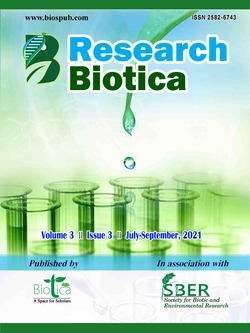
Soil Erosion from Farming Lands in Tropical Islands of India
B.K. Nanda*
ICAR-Krishi Vigyan Kendra, Central Island Agricultural Research Institute, Port Blair, Andaman and Nicobar Islands (744 101), India
N. Sahoo
Dept. of Soil and Water Conservation Engineering, College of Agricultural Engineering and Technology, Odisha University of Agriculture and Technology, Bhubaneswar, Odisha (751 003), India
B. Panigrahi
Dept. of Soil and Water Conservation Engineering, College of Agricultural Engineering and Technology, Odisha University of Agriculture and Technology, Bhubaneswar, Odisha (751 003), India
DOI: https://doi.org/10.54083/ResBio.3.3.2021.170-175
Keywords: Bay islands, Erosivity, Land degradation, Soil loss, USLE
Abstract
Soil erosion from crop lands of tropical South Andaman district in Bay Islands of India was estimated using the Universal Soil Loss Equation. Using 38 years of rainfall, monthly and annual values of rainfall erosivity (R) were determined. Average monthly value of R was ranged from 1.48 to 132.67 metric ton.m.ha-1hr-1. It was observed that 103.77 thousand tonnes of soil were lost annually from the cultivable area of the district at the rate of 59.40 t ha-1yr-1. Under the single cropped land, green gram cultivated in kharif season contributes highest rate of soil loss (83.64 t ha-1yr-1) and ginger yields lowest rate of soil loss (22.17 t ha-1yr-1), whereas, for double cropped land, sweet potato-vegetable-fallow contributes lowest rate of soil loss (24.91 t ha-1yr-1) and green gram-vegetable-fallow yield highest rate of soil loss (79.09 t ha-1yr-1). Mono-cropped land contributed more soil loss due to upland farming situation, thin canopy, weak soil binding by crop roots, more erodibility and erosivity in the peak soil-eroding season and fallow state of crop lands. The average annual rate of soil loss in mono-crop land was estimated as 59.40 t ha-1yr-1 and that of double cropped land was estimated as 42.63 t ha-1yr-1. It is assessed that there would be a reduction of 28.23% soil loss if the mono cropped land is converted to double cropped land in the district.
Downloads
not found
Reference
Ahmad, I., Verma, M.K., 2013. Application of USLE model & GIS in estimation of soil erosion for Tandula reservoir. International Journal of Emerging Technology and Advanced Engineering 3(4), 570-576.
Bhattacharyya, R., Ghosh, B.N., Mishra, P.K., Mandal, B., Rao, C.S., Sarkar, D., Das, K., Anil, K.S., Lalitha, M., Hati, K.M., Franzluebbers, A.J., 2015. Soil degradation in India: Challenges and potential solutions. Sustainability 7, 3528-3570.
Brandon, C., Hommann, K., Kishore, N.M., 1995. The cost of inaction: Valuing the economy wide cost of environmental degradation in India. In: Proceedings of the UNU Conference on the Sustainable Future of the Global System. Tokyo, October, 1995. pp. 16-18.
Erasmus, I.E., Lal, M., Raghunath, B., Mathur, P.S., 1970. Evaluation of erosion potential for daily rainfall data. Indian Forester 96(2), 817-825.
Ghosh, S.P., Babu, R., 1977. Effect of dominant fruit crops and their management on runoff and soil loss on sloping land. Soil Conservation Digest 5(1), 15-18.
Kurothe, R.S., 1991. Soil erosion map of Gujarat. Indian Journal of Soil Conservation 25(1), 9-13.
Mannering, J.V., 1981. The use of soil tolerances as strategy for soil conservation. In: Soil Conservation Problem and Prospect. (Ed.) Morgan, R.P.C. Jhon Willey & Sons, Chichester, England. pp. 337-349.
NBSS&LUP, 2014. National Bureau of Soil Survey and Land Use Planning, India. Soil Map (1:1 Million Scale); NBSS&LUP: Nagpur, India, 2004.
Naik, B.S., Paul, J.C., Panigrahi, B., Sahoo, B.C., 2015. Soil erosion assessment from farming lands of Koraput district in Eastern Ghat region of Odisha. Indian Journal of Soil Conservation 43(1), 33-37.
Naik, B.S., Paul, J.C., Panigrahi, B., Sahoo, B.C., 2014. Soil loss from agricultural lands in eastern ghat of Odisha - A case study of Koraput district. Journal of Soil and Water Conservation 13(4), 324-329.
Nanda, B.K., Sahoo, N., Panigrahi, B., 2018. Agroclimatic conditions, cropping pattern and its profitability in South Andaman district of Bay Islands. Journal of Krishi Vigyan 7(1), 4-9.
Pandey, C.B., Rai, R.B., Singh, L., Singh, A.K., 2007. Homegardens of Andaman and Nicobar, India. Agricultural Systems 92, 1-22.
Pandey, C.B., Singh, L., 2009. Soil fertility under homegarden trees and native moist evergreen forest in South Andaman, India. Journal of Sustainable Agriculture 33(30), 303-318.
Panigrahi, D., 2007. Water and land use optimization in hill plateaus of Orissa. Unpublished Ph.D. Thesis, Utkal University, Bhubaneswar.
Raghunath, B., Erasmus, I.E., 1971. A method for estimating erosion potential from daily rainfall data. Indian Forester 97(3), 121-125.
Reddy, V.R., 2003. Land degradation in India: Extent, costs and determinants. Economic and Political Weekly 38, 4700-4713.
Roose, E.J., 1976. Use of the universal soil loss equation to predict erosion in West Africa. In: Soil Erosion: Prediction and Control. Soil Conservation Society of America, Ankeny, Iowa. pp. 60-74.
Sahoo, A.K., Das, K., Das, A.L., Obi Reddy, G.P., Singh, S.K., Sarkar, D., Mishra, P.K., 2013. Soil Erosion of Andaman & Nicobar Islands. NBSS Publ. No. 165, NBSS&LUP (ICAR), Nagpur. p. 30.
Sharda, V.N., Dogra, P., Prakash, C., 2010. Assessment of production losses due to water erosion in rainfed areas of India. Journal of Soil and Water Conservation 65, 79-91.
Shri Niwas, Gupta, P.D., Das, S.K., 1980. Runoff and soil loss studies on red chalka soils at Hyderabad. In: National Symposium on Soil Conservation and Water Management in 1980's. Dehradun, March 12-13, 1980.
Singh, G., Ram Babu, Chandra, S., 1981. Soil Loss Prediction Research in India. Bulletin No. T-12/D-9, CSWCRTI, Dehradun.
Suresh, R., Das, G., Singh, J.K., 2002. Estimation of soil loss generating potential of various land use activities in Naurar watershed of Ramganga catchment, UP (India). Journal of Indian Water Resource Society 22(3), 107-116.
Velmurugan, A., Swarnam, T.P., Kumar, P., Ravishankar, N., 2008. Soil erosion assessment using revised Morgan, Morgan Finney model for prioritization of Dhanikhari watershed in South Andaman. Indian Journal of Soil Conservation 36(3), 173-179.
Wischmeir, W.H., 1959. A rainfall erosion index for universal soil loss equation. Soil Science Society of America Proceedings 23, 246-249.
Wischmeier, W.H., Smith, D.D., 1978. Predicting Rainfall-Erosion Losses: A Guide to Conservation Planning. U.S. Dept. of Agriculture, Agriculture Handbook. p. 537.
